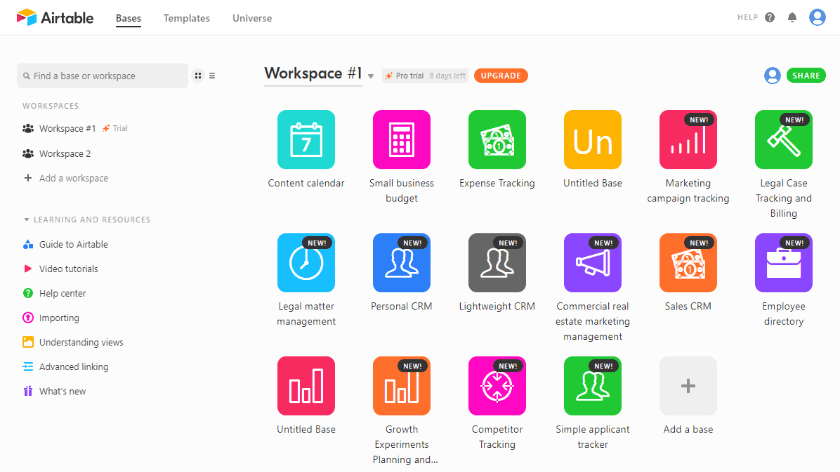Airtables' road to Enterprise: Key Lessons For Product Managers
This interview with Airtable's co-founder is a fantastic case study on how to build an enterprise platform while staying customer-first.
Ever had that moment while listening to a podcast where everything clicks? When you find yourself nodding along, entirely in sync with the speaker, absorbing every nugget of wisdom? That’s exactly how I felt listening to Liu Howie on the No Priors podcast.
This interview with Airtable's co-founder is a fantastic case study on how to build an enterprise platform while staying customer-first. In this article, I highlight Liu's critical comments and discuss their relevance to Product Managers.
I recommend you listen to the podcast before diving into this post. I promise it’s worth it!
The Origin and Evolution of Airtable
Airtable serves over half a million organizations, including notable names like Amazon and Adobe. Airtable was designed as a "spreadsheet on steroids" and bridges the gap between low-code platforms and simple project management tools, offering users the ability to build real applications.
Liu states,
We give people the ability to build real apps with a real relational data structure... but did it in a way that was so much easier to use.
Liu's experience at Salesforce inspired him to create a more accessible app platform:
Working within Salesforce, I saw the power of the platform model... and wanted to democratize it...Salesforce does not win because they built all the CRM features but because they built a platform that can be customized for all those customer needs
Liu hits the nail on the head. Pure app-play startups rarely reach multi-billion dollar valuations. Being niche helps you compete and differentiate your offering. However, it also reduces your TAM and the overall attractiveness of your product.
Liu recognizes that customer use cases are diverse and cannot be solved by a one-size-fits-all app. Extensibility is key. A platform provides that and more. That's why the combo app/platform is so powerful. I experienced it firsthand while in charge of Salesforce PRM.
Airtable's design focuses on being user-friendly, making it intuitive for those accustomed to traditional spreadsheets.
Liu notes,
It was important that Airtable felt as easy to use as a spreadsheet... the initial version of the product was very grid-centric… everybody has used spreadsheets… we are four decades in… the spreadsheet product has paid the cost of going into a new category… We made an intentional set of design choices to make Airtable as approachable and sometimes feel like a spreadsheet…made it as easy to use as a spreadsheet with the same shortcuts…
This section resonated so much with me. In 2015, we relaunched our Salesforce portal offering with an app-first approach. We invested heavily in quick and easy deployment through templates and OOTB components. Having an app that is quick and easy to deploy is critical for most buyers. You cannot just sell a platform and tell your buyer to build the app.
Airtable's decision to copy the spreadsheet UX paradigm was genius. Everyone thinks they must be different, so looking like the big guy and making it your competitive advantage takes some vista. They traded innovation for trust and removed a lot of friction and anxiety with early adopters. Overnight, their TAM included 500M spreadsheet users. They could inspire prospects with relevant business use cases and demonstrate ROI without explaining how the app works. Hats off to the Airtable product team!
Challenges and Successes in Building Airtable
Liu discusses the challenges of building a platform, highlighting the strategy of starting with a simple product and increasing complexity over time. He remarks,
It is harder to start with a complicated product like SAP and try to make it simpler… it is very common to start with a very simple product and make it more powerful, complex, customizable…
This strategy has been crucial in Airtable's adoption and growth, allowing it to undercut bigger Cloud software players. No matter how tempting it is for startups to become the next big Platform player, this requires a humble beginning with an App-first focus. Nobody buys a Platform. Customers seek business solutions.
Liu adds,
Start with a very low floor… get the floor as low as possible… we are coming in and undercutting all the local app platforms like Salesforce, Service Now, all those old school products… over time we can improve the ceiling, we want to improve data scale… add new layers of extensibility… code extensibility so you can write your code logic with automation
Besides the product philosophy, there is a critical GTM angle here. Airtable probably targeted small customers (SMBs) who are cost-conscious and cannot afford to pay $5 for every $1 of software spent (the SaaS industry average). It's every startup's dream to win the lottery with Enterprise. The reality is strikingly different. It is Mission Impossible to displace Enterprise software leaders without a strong product, a well-established brand, and money to go upmarket with your GTM.
Liu adds,
…had we try to go hard to the Enterprise in the first few years would have been difficult because some of the bigger user cases would have broken our product…it took us some time to get to those more ambitious use cases
Oh boy, this is so true! I joined Salesforce as a 2x Saas founder and learned the hard way what it takes to build Enterprise software. It is hard and slow. Customer expectations are incredibly high. On the other hand, startups can quickly put code together and ship software that works for SMBs but is unfit for the Enterprise. This competitive advantage dissipates as the startup grows into a mature company and tries to enter the Enterprise space.
Airtable’s Transition to Enterprise Solutions
Airtable has evolved to support enterprise-level use cases with increased data handling capabilities and extensibility. Liu explains,
We've been able to lean more into enterprise because we've made these platform investments... supporting the most ambitious use cases.
I'm impressed by the foresight of Liu and Airtable's founders. The transition from App to Platform is challenging. An "App PM" will usually not do well as a "Platform PM" and vice versa. Airtable copied Salesforce's approach: ship the CRM app and extend it with a robust platform. During my time leading the PRM app, I remember numerous examples where we won deals thanks to our Platform extensibility. We were able to address use cases in our non-core verticals and go to places where point-solutions show their limits.
Liu states,
It took us time to make the platform scalable... so we could go after larger use cases without breaking the product.
The transition from App to Platform is HARD. It probably takes three to five years to transform an app into a mature Platform solution. Once you have a Platform, it is a very different product strategy and mindset.
Lui adds,
we started to get enough organic adoption resulting in enough usage and high value use cases merging organically and start lean in into those rather than of having to invent new use cases or vertical solution
It is often tempting to grow by entering new markets. Airtable decided to build its Platform on top of its core app use case. It makes a lot of sense. You want to build upon your strengths and, as a result, expand your TAM.
Insights on Product Management
Liu describes the complexity of product management, emphasizing the need for roles that focus both on technical (inbound) and market aspects (outbound). Liu says,
Product management is really hard to do well... it's about understanding the market and technical capabilities.
It is, indeed. We discussed this in earlier posts (here, here, and here).
He mentions a shift in the industry towards separating product management into specialized roles. Liu shares,
lots of PM functions are more inward looking… what are we building.. what is going to be hard about it... How de we keep technical capabilities on track… engineering on time.. more of the program mngt side of things
The separation of PM roles is somewhere natural. More junior PMs own a feature and focus on execution. They have a limited say in the overall strategy and product directions. Those individuals practice their craft by working with scrum teams, writing specs, etc. As PMs grow, they become more involved in product vision and strategy, first within their domain expertise and later at a product portfolio level.
Liu hints at the separation of inbound and outbound PM roles. The more senior you get, the fewer inbound responsibilities you have and the more outbound you perform (GTM, marketing positioning, pricing and packaging, customer and partner relationships, etc.).
Liu adds,
product marketing is often neglected in PM.. it’s starting from the customer from the market who is our competition what is the problem we are trying to solve… the JTBD (Job To Be Done) was meant to put emphasis on it.. framework alone does not solve the problem
At Salesforce, we’re fortunate to have Product Marketing Managers (PMMs) collaborate closely with Product Managers (PMs). For the PM/PMM relationship to thrive, two key ingredients are essential: the PM must have a solid grasp of go-to-market (GTM) strategies and product positioning, while the PMM needs a deep understanding of upcoming product innovation. I’ve often partnered with my PMM counterpart to develop GTM and product messaging early in the innovation cycle. In contrast, startups often don’t have the luxury of dedicated PMMs and must rely on a jack-of-all-trades PM.
Finally, Liu says:
PM third hat deals with complexity… in the Google PM days you had good people who could think about the information architecture .. emphasis on people who could think about those hard to fix problems
Liu voices the challenges of finding well-rounded PMs who can deliver on all fronts (Inbound vs. Outbound, Apps vs. Enterprise) and be decisive in their prioritization. As a company like Airtable grows, it inherently deals with product portfolio complexity and higher customer demands.
When asked what it’s like to be a Product Manager for an Enterprise Software company, I often use this analogy: In a single day, you might speak with four different customers. The first wants your product to move North, the second demands it go East, the third pushes for South, and the fourth is only interested in heading West. Who says Product Management is boring?
Integrating AI into Airtable
Liu was vague about Airtable's AI strategy. The company recently introduced Airtable Cobuilder as its LCAP AI tool. I still need to review it. One thing is for sure: AI will disrupt the LCAP space. Let me know if you'd like me to write about this topic.
Conclusion
We had a great PM intern this summer, super smart, and promised a brilliant future. In our exit interview, we chatted about his goals for next year. He is eager to learn about AI and plans to take an online course. I praise his desire to keep learning. However, PMs should distinguish knowledge from experience. The best PMs got where they are by building products, often failing before getting it right. Airtable's journey to success and the critical decisions Liu made represent a unique case study for anyone trying to compete in the Enterprise space.



